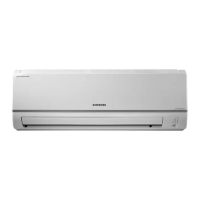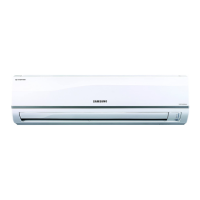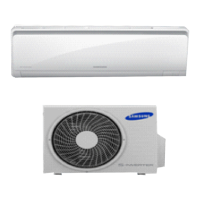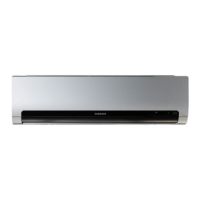Do you have a question about the Samsung AQV09NSBN and is the answer not in the manual?
Highlights the BLDC technology for efficient cooling and heating with high energy saving.
Describes the product's aesthetic appeal and integration into interiors.
Explains the mode designed for comfortable sleep and refreshed waking.
Details the use of Silver Nano and Catechin filters for air purification.
Focuses on the extremely quiet operation of the air conditioner.
Advises on proper installation to prevent hazards like fire, leakage, or shock.
Details power connection and circuit protection needs for safe operation.
Outlines safe procedures to follow during the air conditioner's use.
Provides guidance on environmentally responsible disposal of the air conditioner.
Covers other important safety notes and general usage recommendations.
Summarizes the main selling points and functionalities of the air conditioner.
Lists comprehensive data for cooling, heating, power, and dimensions.
Compares technical data between different models like AQV09NSD and AQV12NSD.
Lists included accessories and optional components for the air conditioner.
Explains how to enter and operate the unit in test mode for diagnosis.
Details how to interpret indoor display error codes and perform checks.
Explains how to read outdoor LED error codes and diagnose issues.
Guides through configuring operational options using the remote control.
Lists essential tools required for disassembly and reassembly tasks.
Provides step-by-step instructions for taking apart the indoor unit.
Details the process for disassembling the outdoor unit.
Shows an exploded view and lists parts for the indoor unit.
Displays an exploded view and parts list for the outdoor unit.
Identifies components within the indoor control assembly (DB93-05132B).
Lists components for the outdoor control assembly.
Lists electrical parts on the main indoor PCB (DB93-05877J).
Details components on the outdoor inverter PCB (DB93-05834CD).
Lists electrical parts for the outdoor main PCB (DB93-06291C).
Illustrates electrical connections within the indoor unit.
Shows electrical connections for the outdoor unit.
Provides the detailed circuit schematic for the indoor unit.
Presents the detailed circuit schematic for the outdoor unit.
Explains the function of various circuits on the PCBs.
Illustrates refrigerant flow during cooling and heating cycles.
Shows component layout and identifies major parts on the indoor PCB.
Displays the component layout for the outdoor inverter PCB.
Illustrates component placement on the outdoor main PCB.
Labels and describes the functional parts of the indoor unit.
Identifies and describes the functional parts of the outdoor unit.
Explains the buttons and display of the wireless remote control.
Details the primary operational modes like Auto, Cool, Heat, Dry, Fan.
Describes special functions like Turbo and Good Morning modes.
Lists basic checks to perform before diagnosing specific problems.
Provides a flowchart for diagnosing a completely dead unit.
Offers steps to diagnose and resolve power supply issues in the outdoor unit.
Guides on diagnosing issues when the up/down louver motor doesn't operate.
Provides troubleshooting steps for errors related to the outdoor unit fan.
Details troubleshooting steps for errors related to total current trips.
Addresses issues where the unit operates in the wrong mode.
Guides on diagnosing and resolving outdoor temperature sensor faults.
Details troubleshooting for errors related to the discharge temperature sensor.
Provides steps for diagnosing errors with the coil temperature sensor.
Guides on diagnosing and resolving general fan errors.
Details troubleshooting for errors related to DC-Link voltage sensors.
Guides on troubleshooting and resolving over current errors.
Provides steps to diagnose and fix communication errors between units.
Guides on troubleshooting issues related to compressor starting.
Details troubleshooting steps for compressor lock errors.
Guides on diagnosing DC Link over/low voltage errors.
Provides steps for troubleshooting when the remote control is not receiving signals.
Covers miscellaneous issues like AC Line Zero Cross Signal and Capacity mismatch.
Lists important safety and handling precautions before inspecting PCBs.
Outlines steps for checking PCB connections and general integrity.
Provides specific inspection steps for the indoor unit's PCB.
Offers detailed inspection procedures for the outdoor unit's PCB.
Details how to inspect key components like sensors and motors.
Shows the functional blocks and data flow within the indoor unit's controller.
Illustrates the functional blocks and data flow of the outdoor unit controller.
Explains the structure and meaning of model name codes.
Provides charts showing refrigerant pressure based on indoor/outdoor temperatures.
Addresses common non-trouble related questions and provides solutions.
Details steps for cleaning the air filters and front grille.
Explains how to clean optional deodorizing and bio filters.
Covers site preparation, pipe work, leak testing, and electrical checks.
Details steps for purging air from the system using a vacuum pump.
Explains the pump down process for evaporator replacement or relocation.
Highlights the BLDC technology for efficient cooling and heating with high energy saving.
Describes the product's aesthetic appeal and integration into interiors.
Explains the mode designed for comfortable sleep and refreshed waking.
Details the use of Silver Nano and Catechin filters for air purification.
Focuses on the extremely quiet operation of the air conditioner.
Advises on proper installation to prevent hazards like fire, leakage, or shock.
Details power connection and circuit protection needs for safe operation.
Outlines safe procedures to follow during the air conditioner's use.
Provides guidance on environmentally responsible disposal of the air conditioner.
Covers other important safety notes and general usage recommendations.
Summarizes the main selling points and functionalities of the air conditioner.
Lists comprehensive data for cooling, heating, power, and dimensions.
Compares technical data between different models like AQV09NSD and AQV12NSD.
Lists included accessories and optional components for the air conditioner.
Explains how to enter and operate the unit in test mode for diagnosis.
Details how to interpret indoor display error codes and perform checks.
Explains how to read outdoor LED error codes and diagnose issues.
Guides through configuring operational options using the remote control.
Lists essential tools required for disassembly and reassembly tasks.
Provides step-by-step instructions for taking apart the indoor unit.
Details the process for disassembling the outdoor unit.
Shows an exploded view and lists parts for the indoor unit.
Displays an exploded view and parts list for the outdoor unit.
Identifies components within the indoor control assembly (DB93-05132B).
Lists components for the outdoor control assembly.
Lists electrical parts on the main indoor PCB (DB93-05877J).
Details components on the outdoor inverter PCB (DB93-05834CD).
Lists electrical parts for the outdoor main PCB (DB93-06291C).
Illustrates electrical connections within the indoor unit.
Shows electrical connections for the outdoor unit.
Provides the detailed circuit schematic for the indoor unit.
Presents the detailed circuit schematic for the outdoor unit.
Explains the function of various circuits on the PCBs.
Illustrates refrigerant flow during cooling and heating cycles.
Shows component layout and identifies major parts on the indoor PCB.
Displays the component layout for the outdoor inverter PCB.
Illustrates component placement on the outdoor main PCB.
Labels and describes the functional parts of the indoor unit.
Identifies and describes the functional parts of the outdoor unit.
Explains the buttons and display of the wireless remote control.
Details the primary operational modes like Auto, Cool, Heat, Dry, Fan.
Describes special functions like Turbo and Good Morning modes.
Lists basic checks to perform before diagnosing specific problems.
Provides a flowchart for diagnosing a completely dead unit.
Offers steps to diagnose and resolve power supply issues in the outdoor unit.
Guides on diagnosing issues when the up/down louver motor doesn't operate.
Provides troubleshooting steps for errors related to the outdoor unit fan.
Details troubleshooting steps for errors related to total current trips.
Addresses issues where the unit operates in the wrong mode.
Guides on diagnosing and resolving outdoor temperature sensor faults.
Details troubleshooting for errors related to the discharge temperature sensor.
Provides steps for diagnosing errors with the coil temperature sensor.
Guides on diagnosing and resolving general fan errors.
Details troubleshooting for errors related to DC-Link voltage sensors.
Guides on troubleshooting and resolving over current errors.
Provides steps to diagnose and fix communication errors between units.
Guides on troubleshooting issues related to compressor starting.
Details troubleshooting steps for compressor lock errors.
Guides on diagnosing DC Link over/low voltage errors.
Provides steps for troubleshooting when the remote control is not receiving signals.
Covers miscellaneous issues like AC Line Zero Cross Signal and Capacity mismatch.
Lists important safety and handling precautions before inspecting PCBs.
Outlines steps for checking PCB connections and general integrity.
Provides specific inspection steps for the indoor unit's PCB.
Offers detailed inspection procedures for the outdoor unit's PCB.
Details how to inspect key components like sensors and motors.
Shows the functional blocks and data flow within the indoor unit's controller.
Illustrates the functional blocks and data flow of the outdoor unit controller.
Explains the structure and meaning of model name codes.
Provides charts showing refrigerant pressure based on indoor/outdoor temperatures.
Addresses common non-trouble related questions and provides solutions.
Details steps for cleaning the air filters and front grille.
Explains how to clean optional deodorizing and bio filters.
Covers site preparation, pipe work, leak testing, and electrical checks.
Details steps for purging air from the system using a vacuum pump.
Explains the pump down process for evaporator replacement or relocation.
| Cooling Capacity | 9000 BTU/h |
|---|---|
| Cooling Capacity (kW) | 2.64 kW |
| Heating Capacity | 10000 BTU/h |
| Power Consumption Cooling | 820 W |
| Energy Efficiency Ratio (Heating) | 3.61 |
| Refrigerant | R410A |
| Noise Level (Indoor Unit) | 38 dB |
| Noise Level (Outdoor Unit) | 50 dB |
| Power Supply | 220-240 V, 50 Hz |












